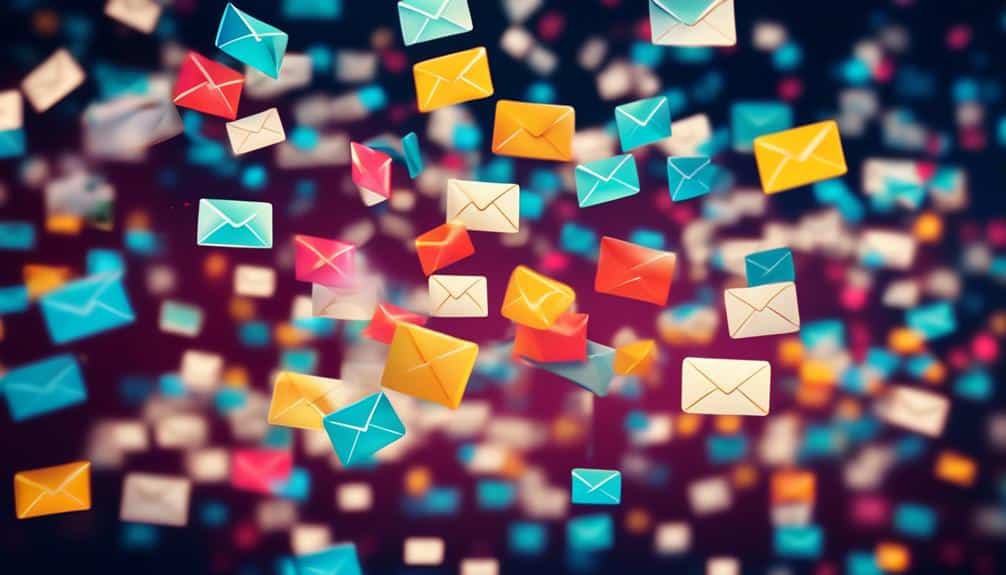Exclusive Release: Master the Art of Email Marketing Before Your Competitors
Are you tired of watching your competitors soar ahead in the world of email marketing while you struggle to keep up? Well, fret no more! We have an exclusive release that will allow you to master the art of email marketing and leave your competitors in the dust.
This comprehensive guide will provide you with the insider knowledge and expert strategies you need to take your email campaigns to the next level. From understanding your target audience to crafting compelling content and designing eye-catching templates, we've got you covered.
So, are you ready to unlock the secrets of email marketing success?
Key Takeaways
- Email marketing allows for direct and personalized engagement with the target audience.
- Maintaining a good sender reputation and using proper email authentication maximize deliverability rates.
- Understanding your target audience through research and segmentation is crucial for effective email marketing.
- Personalization and customization are key to delivering relevant and engaging content to subscribers.
Why Email Marketing Matters

Email marketing is an essential tool for businesses, enabling you to directly reach and engage with your target audience in a highly personalized and impactful way. But to truly master email marketing, it's crucial to understand two important aspects: email deliverability and email marketing metrics.
First, let's delve into email deliverability. This refers to the ability of your emails to successfully land in your recipients' inboxes. It doesn't matter how great your email content is if it never reaches your audience. Understanding email deliverability involves ensuring that your emails aren't marked as spam and are delivered to the intended recipients. By maintaining a good sender reputation, using proper email authentication, and regularly monitoring your deliverability rates, you can maximize the chances of your emails being delivered and read.
Now let's move on to email marketing metrics. These metrics provide valuable insights into the effectiveness of your email campaigns. They help you understand how your audience is engaging with your emails, allowing you to make data-driven decisions to optimize your campaigns. Key metrics to track include open rate, click-through rate, conversion rate, and unsubscribe rate. By analyzing these metrics, you can identify what resonates with your audience, make necessary adjustments, and improve the overall success of your email marketing efforts.
Understanding Your Target Audience
Now, let's shift our focus to understanding your target audience in order to maximize the effectiveness of your email marketing campaigns. Conducting a target audience analysis is essential to ensure that your email marketing strategies resonate with your audience and drive results.
Here are four key steps to help you better understand your target audience:
- Research and gather data: Start by collecting demographic information, such as age, gender, location, and interests. This data will give you valuable insights into who your audience is and what they're interested in.
- Develop buyer personas: Create detailed profiles of your ideal customers based on the data you've gathered. These personas will help you understand their motivations, challenges, and preferences, allowing you to tailor your email content to their specific needs.
- Segment your audience: Divide your audience into smaller groups based on common characteristics or behaviors. This segmentation allows you to deliver more personalized and targeted email campaigns, increasing engagement and conversions.
- Continuously analyze and update: Regularly review and analyze your email marketing metrics to gain insights into what's working and what needs improvement. Use this information to refine your strategies and ensure that you're effectively reaching and engaging your target audience.
Building an Effective Email List

To build an effective email list, you need to focus on targeted audience segmentation, optimizing your opt-in forms, and personalizing your emails.
By segmenting your audience based on their interests and preferences, you can send them more relevant content.
Optimizing your opt-in forms will ensure that you capture the right information and encourage more sign-ups.
Personalizing your emails with the recipient's name and tailoring the content to their needs will increase engagement and conversion rates.
Targeted Audience Segmentation
By effectively segmenting your audience, you can build an email list that delivers targeted and personalized content to engage and convert your subscribers. Here's why targeted audience segmentation is crucial for your email marketing success:
- Increased Relevance: Segmenting your audience allows you to tailor your messages specifically to their needs and interests, making your emails more relevant and valuable to them.
- Improved Engagement: When you send targeted emails, you're more likely to capture your subscribers' attention and encourage them to take action, leading to higher engagement rates.
- Higher Conversion Rates: By delivering personalized content to the right people at the right time, you can significantly increase your chances of converting subscribers into customers.
- Automation Efficiency: Utilizing customer profiling and email marketing automation tools enables you to automate the segmentation process, saving you time and effort while ensuring precision and accuracy.
Segmenting your audience is a strategic approach that allows you to serve your subscribers better, resulting in a more successful email marketing campaign.
Opt-In Forms Optimization
Are you ready to optimize your opt-in forms and build a highly effective email list?
To maximize your conversion rate optimization and implement successful lead generation strategies, it's crucial to optimize your opt-in forms.
Start by strategically placing your opt-in forms in high-visibility areas on your website, such as the homepage and landing pages.
Keep your forms simple and concise, asking for only essential information to reduce friction and increase form completion rates.
Additionally, use compelling copy and visuals to grab your audience's attention and entice them to subscribe.
Experiment with different form styles and placements to find what works best for your audience.
Personalization and Customization
Build a highly effective email list by personalizing and customizing your email marketing campaigns. To stay ahead in the competitive world of email marketing, it's crucial to embrace the latest email personalization trends. Here are some key strategies to consider:
- Tailor your content: Craft personalized recommendations based on your subscribers' preferences and previous interactions.
- Segment your audience: Divide your email list into smaller, targeted groups to send more relevant and personalized content.
- Dynamic content: Use dynamic content blocks to create personalized email experiences based on each subscriber's unique characteristics.
- Automation: Set up automated workflows that deliver personalized emails at the right time, ensuring your subscribers receive timely and relevant information.
Crafting Compelling Email Content

Are your email subject lines captivating enough to make your recipients open your emails?
Craft persuasive subject lines that grab attention and entice curiosity.
Personalize your email greetings to make your recipients feel valued and appreciated.
Optimize your call-to-action by making it clear, compelling, and action-oriented, driving your recipients to take the desired action.
Persuasive Subject Lines
Craft compelling email content by utilizing persuasive subject lines that captivate your audience's attention and entice them to open your emails.
To increase your open rates and engage your audience effectively, consider the following tips:
- Use power words: Incorporate strong and action-oriented language to create a sense of urgency and excitement.
- Personalize your subject lines: Address your audience by their first name to make them feel valued and increase the chances of them opening your emails.
- Ask intriguing questions: Pose thought-provoking questions that pique your audience's curiosity and compel them to find the answers within your email.
- Use numbers and statistics: Incorporate specific numbers and statistics to provide concrete evidence and make your subject lines more compelling.
Personalized Email Greetings
To create a personalized connection with your audience, start your email with a warm and inviting greeting.
Personalized email greetings can make a significant difference in engaging your recipients and increasing the effectiveness of your email campaigns. By using email personalization techniques, such as addressing the recipient by their first name or mentioning their recent purchase, you can make your emails feel more tailored to their needs and interests.
This level of personalization not only grabs their attention but also shows that you value them as an individual. The benefits of personalized emails go beyond just making a good first impression. They can lead to higher open rates, click-through rates, and ultimately, more conversions.
Call-To-Action Optimization
Optimize your call-to-action in email marketing by crafting compelling content that motivates your recipients to take action. A strong call-to-action can greatly enhance the effectiveness of your emails and improve your email conversion rates.
To optimize your call-to-action, consider the following:
- Use clear and concise language: Make your call-to-action easy to understand and ensure it clearly communicates what action you want the recipient to take.
- Create a sense of urgency: Encourage immediate action by using words like 'limited time offer' or 'act now'.
- Offer incentives: Provide an enticing offer or incentive to motivate your recipients to take action.
- Use compelling visuals: Incorporate eye-catching graphics or buttons to grab attention and entice clicks.
Designing Eye-Catching Email Templates

When designing eye-catching email templates, consider incorporating visually appealing graphics and engaging content to captivate your audience's attention. To create an email template that stands out, here are some email design tips and visual branding strategies to keep in mind:
| Column 1 | Column 2 | Column 3 |
|---|---|---|
| Use a clean and simple layout | Choose a color palette that aligns with your brand | Include high-quality images |
| Make your email mobile-friendly | Utilize white space to improve readability | Use fonts that are easy to read |
| Personalize your emails with dynamic content | Include a clear and compelling call-to-action | Test your email template before sending |
Optimizing Email Subject Lines
Improve your email marketing strategy with attention-grabbing subject lines. Writing effective and engaging emails starts with optimizing your subject lines. By creating compelling subject lines, you can increase email open rates and capture the attention of your audience.
Here are four tips to help you craft subject lines that stand out:
- Keep it concise: Aim for subject lines that are short and to the point. Avoid using unnecessary words or phrases that may confuse or bore your readers.
- Use action-oriented language: Incorporate verbs and strong action words to create a sense of urgency and encourage recipients to open your email.
- Personalize when possible: Tailor your subject lines to the recipient by using their name or referencing previous interactions. This personal touch can make your emails feel more relevant and increase open rates.
- Test and analyze: Experiment with different subject lines and monitor the results. Use A/B testing to determine which subject lines resonate best with your audience and adapt your strategy accordingly.
Personalization and Segmentation Strategies

Are your email marketing campaigns falling flat? It's time to take a closer look at your approach.
By implementing targeted content customization and audience segmentation techniques, you can enhance the effectiveness of your emails. Personalization allows you to deliver tailored messages that resonate with your subscribers, increasing engagement and conversions.
Segmenting your audience further enables you to send relevant content to specific groups, maximizing the impact of your email marketing efforts.
Don't waste another opportunity – start personalizing and segmenting your emails today.
Targeted Content Customization
To maximize the effectiveness of your email marketing campaigns, implement targeted content customization strategies that ensure personalized and segmented messaging. By tailoring your content to each recipient's interests and preferences, you can significantly increase engagement and conversion rates.
Here are four essential tactics to help you master targeted content customization:
- Utilize data: Leverage customer data and behavior to create relevant and personalized email content.
- Segment your audience: Divide your email list into smaller, more specific groups based on demographics, interests, or purchase history.
- Dynamic content: Use dynamic elements in your emails to personalize the message based on each recipient's preferences.
- Automation: Implement email automation tools to send targeted messages at the right time, ensuring maximum impact.
Audience Segmentation Techniques
By implementing audience segmentation techniques, you can further enhance targeted content customization in your email marketing campaigns. Customer profiling plays a crucial role in this process. By analyzing your customers' characteristics, behaviors, and preferences, you can divide them into distinct segments.
This allows you to create personalized content that resonates with each segment, increasing engagement and conversions. Not only does audience segmentation improve the relevancy and effectiveness of your email campaigns, but it also enhances email deliverability.
By sending tailored messages to specific segments, you can avoid overwhelming your subscribers with irrelevant content, reducing the likelihood of them hitting the unsubscribe button or marking your emails as spam.
A/B Testing for Email Success
Improve the effectiveness of your email marketing campaigns by utilizing A/B testing for email success. A/B testing allows you to experiment with different elements of your emails to determine what resonates best with your audience. By testing different variables and analyzing the results, you can make data-driven decisions to optimize your email campaigns for maximum impact.
Here are some key benefits of A/B testing for email success:
- Higher Open Rates: Test different subject lines to see which ones generate the most opens. Craft compelling subject lines that pique curiosity or offer a clear benefit to entice recipients to open your emails.
- Improved Click-Through Rates: Experiment with different calls-to-action (CTAs) to see which ones drive the most clicks. Use action-oriented language and make your CTAs stand out visually to encourage recipients to take the desired action.
- Enhanced Email Design: Test different email designs to see which layouts, colors, and visuals engage your audience the most. Follow email design best practices to create visually appealing and user-friendly emails that capture attention.
- Optimized Deliverability: Test different sender names and email addresses to ensure your emails are delivered to the inbox and not marked as spam. Implement email deliverability tips, such as using a reputable email service provider and maintaining a clean email list, to maximize deliverability.
Nurturing Leads With Email Automation

Utilize email automation to effectively nurture leads and drive conversions. With email automation, you can streamline your lead nurturing process and deliver personalized content that resonates with your audience.
One key feature of email automation is lead scoring, which allows you to assign a score to each lead based on their level of engagement and interest. By tracking how leads interact with your emails, you can identify the most engaged prospects and prioritize your efforts accordingly.
Email tracking is another valuable aspect of email automation. It enables you to monitor the performance of your email campaigns, including open rates, click-through rates, and conversions. By analyzing these metrics, you can gain insights into what works and what doesn't, allowing you to refine your email marketing strategy for optimal results.
By leveraging email automation, you can nurture your leads with personalized, targeted content that speaks directly to their needs and interests. This not only helps build trust and credibility but also increases the likelihood of conversions.
With lead scoring and email tracking, you can measure the effectiveness of your campaigns and make data-driven decisions to optimize your email marketing efforts.
Analyzing and Improving Email Campaign Performance
To optimize your email marketing efforts, it's crucial to analyze and enhance the performance of your email campaigns. By conducting thorough email campaign analysis and implementing strategies for email performance improvement, you can take your email marketing to the next level and stay ahead of your competitors.
Here are some key steps to help you analyze and improve the performance of your email campaigns:
- Track and measure key metrics: Monitor important metrics such as open rates, click-through rates, conversion rates, and unsubscribe rates to gain insights into the effectiveness of your email campaigns.
- Segment your audience: Segmenting your email list based on demographics, interests, or behavior allows you to personalize your messages and target specific groups, increasing the relevance and engagement of your emails.
- Test different elements: Experiment with different subject lines, email layouts, call-to-action buttons, and content to determine what resonates best with your audience. A/B testing can provide valuable insights to optimize your campaigns.
- Continuously refine and optimize: Regularly review your email campaign performance and make adjustments based on the data you collect. Identify areas for improvement and implement changes to enhance the effectiveness of your emails.
Frequently Asked Questions
How Can I Measure the Success of My Email Marketing Campaigns?
To measure the success of your email marketing campaigns, use email marketing analytics. Key metrics for email marketing success include open rates, click-through rates, conversion rates, and unsubscribe rates. Track and analyze these metrics to optimize your campaigns.
What Are Some Common Mistakes to Avoid When Sending Marketing Emails?
When sending marketing emails, it's important to avoid common mistakes. Remember to personalize your emails, use clear and compelling subject lines, avoid spammy language, and always provide valuable content to your recipients.
How Often Should I Send Emails to My Subscribers?
You should send emails to your subscribers based on their preferences and needs. Use email segmentation to tailor your content and frequency. This will help you engage and serve your audience effectively.
What Are Some Effective Strategies for Increasing Open Rates and Click-Through Rates?
Increase your open rates and click-through rates by utilizing personalization techniques and optimizing your subject lines. Tailor your emails to your audience's interests and needs, and craft compelling subject lines that grab their attention.
How Can I Avoid My Emails Being Marked as Spam by Recipients?
To avoid your emails being marked as spam, focus on email deliverability and follow best practices in email marketing. By using engaging subject lines, sending relevant content, and maintaining a clean email list, you can increase your chances of reaching your recipients' inboxes.
Conclusion
Mastering the art of email marketing is essential for staying ahead of your competitors. By understanding your target audience, building effective email lists, and implementing personalization and segmentation strategies, you can create impactful email campaigns.
Crafting compelling content and designing eye-catching templates are also crucial elements in email marketing. A well-written and visually appealing email will grab the attention of your recipients and increase the chances of conversion.
In addition to these strategies, A/B testing and email automation can further enhance your success. A/B testing allows you to experiment with different elements of your emails, such as subject lines or call-to-action buttons, to determine what works best for your audience.
Email automation, on the other hand, enables you to send targeted and timely emails without manual intervention. This can save you time and effort while ensuring that your emails are delivered at the right moment.
By continuously analyzing the performance of your email campaigns and making improvements based on the data, you can optimize your results and effectively nurture leads.
Email marketing is a powerful tool that can give you a competitive edge in the digital landscape. Don't miss out on the opportunity to connect with your audience and drive meaningful engagement through well-crafted and targeted emails.








